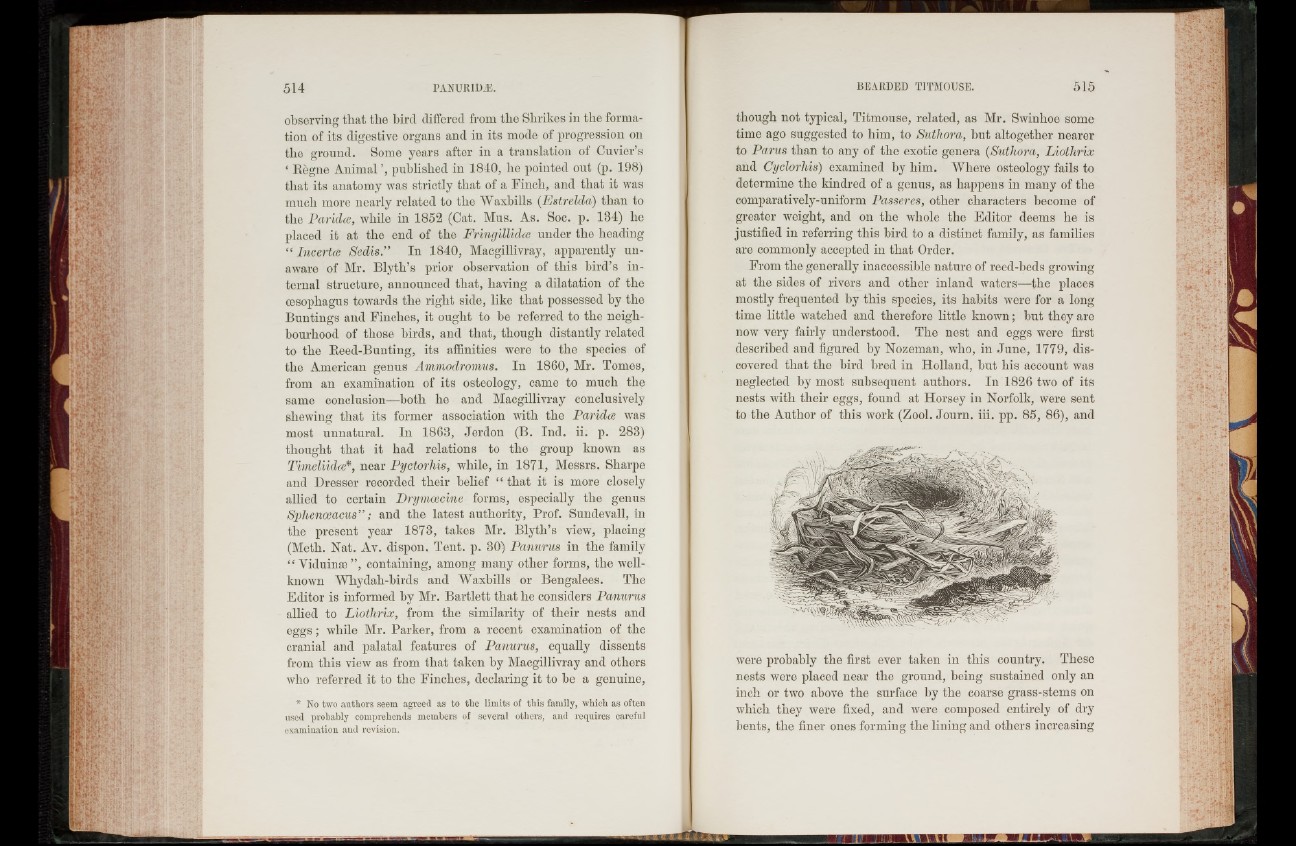
observing that the bird differed from tlie Shrikes in the formation
of its digestive organs and in its mode of progression on
the ground. Some years after in a translation of Cuvier’s
‘ Rógne Animal published in 1840, he pointed out (p. 198)
that its anatomy was strictly that of a Finch, and that it was
much more nearly related to the Waxbills (Estrelda) than to
the Paridee, while in 1852 (Cat. Mus. As. Soc. p. 134) he
placed it at the end of the Fringillidce under the heading
“ Incerta Sedisi’ In 1840, Macgillivray, apparently unaware
of Mr. Blyth’s prior observation of this bird’s internal
structure, announced that, having a dilatation of the
cesophagus towards the right side, like that possessed by the
Buntings and Finches, it ought to be referred to the neighbourhood
of those birds, and that, though distantly related
to the Reed-Bunting, its affinities were to the species of
the American genus Ammodromus. In 1860, Mr. Tomes,
from an examination of its osteology, came to much the
same conclusion—both he and Macgillivray conclusively
shewing that its former association with the Pavida was
most unnatural. In 1863, Jerdon (B. Ind. ii. p. 283)
thought that it had relations to the group known as
Timeliidce*, near Pyctorhis, while, in 1871, Messrs. Sharpe
and Dresser recorded their belief “ that it is more closely
allied to certain Drymcecine forms, especially the genus
Splienceacus” ; and the latest authority, Prof. Sundevall, in
the present year 1873, takes Mr. Blyth’s view, placing
(Meth. Nat. Av. dispon. Tent. p. 30) Panurus in the family
“ Yiduinse”, containing, among many other forms, the well-
known Whydah-birds and Waxbills or Bengalees. The
Editor is informed by Mr. Bartlett that he considers Panurus
allied to Liothrix, from the similarity of their nests and
eggs ; while Mr. Parker, from a recent examination of the
cranial and palatal features of Panurus, equally dissents
from this view as from that taken by Macgillivray and others
who referred it to the Finches, declaring it to be a genuine,
* No two authors seem agreed as to the limits of this family, which as often
used probably comprehends members of several others, and requires careful
examination and revision.
though not typical, Titmouse, related, as Mr. Swinhoe some
time ago suggested to him, to Suthora, but altogether nearer
to Parus than to any of the exotic genera (Sutliora, Liothrix
and Cyclorhis) examined by him. Where osteology fails to
determine the kindred of a genus, as happens in many of the
comparatively-uniform Passeres, other characters become of
greater weight, and on the whole the Editor deems he is
justified in referring this bird to a distinct family, as families
are commonly accepted in that Order.
From the generally inaccessible nature of reed-beds growing
at the sides of rivers and other inland waters—the places
mostly frequented by this species, its habits were for a long
time little watched and therefore little known; but they are
now very fairly understood. The nest and eggs were first
described and figured by Nozeman, who, in June, 1779, discovered
that the bird bred in Holland, but his account was
neglected by most subsequent authors. In 1826 two of its
nests with their eggs, found at Horsey in Norfolk, were sent
to the Author of this work (Zool. Journ. iii. pp. 85, 86), and
were probably the first ever taken in this country. These
nests were placed near the ground, being sustained only an
inch or two above the surface by the coarse grass-stems on
which they were fixed, and were composed entirely of dry
bents, the finer ones forming the lining and others increasing